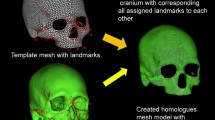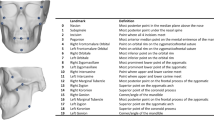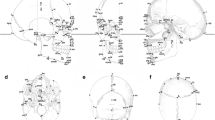Abstract
The endocranial cavity is a major source of information for the assessment of brain morphology in extinct species. Digital molds of the endocranium can be reconstructed from fossil remains. In paleoneurology, these so-called endocasts are examined using shape analysis and multivariate statistical methods to quantify differences among species and individuals. These surfaces are relatively smooth and offer few landmarks; as such, morphometric comparisons are not straightforward, and correspondence search algorithms are necessary to identify loci of equivalent anatomical variation. Many solutions to this so-called correspondence problem have been proposed, but these often require considerable manual input. Here, we present the application in paleoneurology of a correspondence search and symmetrization algorithm originally designed for facial and palatal scans. Homologous representations of surfaces were used to render a computed visualization of differences in shape between modern humans, Neanderthals, archaic humans, and chimpanzees.
Similar content being viewed by others
References
Balzeau A, Grimaud-Hervé D, Détroit F, Holloway RL, Combès B, Prima S (2012) First description of the Cro-Magnon 1 endocast and study of brain variation and evolution in anatomically modern Homo sapiens. Bull Mém Soc Anthropol 25:1–18
Barrick TR, Mackay CE, Prima S, Maes F, Vandermeulen D, Crow TJ, Roberts N (2005) Automatic analysis of cerebral asymmetry: an exploratory study of the relationship between brain torque and planum temporale asymmetry. NeuroImage 24:678–691
Barton RA, Venditti C (2013) Human frontal lobes are not relatively large. PNAS 110:9001–9006
Bastir M, Rosas A, Gunz P, Peña-Melian A, Manzi G, Harvati K, Kruszynski R, Stringer C, Hublin JJ (2011) Evolution of the base of the brain in highly encephalized human species. Nat Commun 2:588
Beaudet A, Bruner E (2017) A frontal lobe surface analysis in three archaic African human fossils: OH 9, Buia, and Bodo. C R Palevol 16:499–507
Beaudet A, Dumoncel J, de Beer F, Duployer B, Durrleman S, Gilissen E, Hoffman J, Tenailleau C, Thackeray JF, Braga J (2016) Morphoarchitectural variation in South African fossil cercopithecoid endocasts. J Hum Evol 101:65–78
Bookstein FL (1989) Principal warps: thin-plate splines and the decomposition of deformations. Pattern Anal Mach Intell IEEE Trans 11:567–585
Bookstein FL (1991) Morphometric tools for landmark data: geometry and biology. Cambridge University Press, New York
Bookstein FL (1997) Landmark methods for forms without landmarks: morphometrics of group differences in outline shape. Med Image Anal 1:225–243
Bookstein FL, Gunz P, Mitterœcker P, Prossinger H, Schæfer K, Seider H (2003) Cranial integration in homo: singular warps analysis of the midsagittal plane in ontogeny and evolution. J Hum Evol 44:167–187
Bruner E (2004) Geometric morphometrics and paleoneurology: brain shape evolution in the genus homo. J Hum Evol 47:279–303
Bruner E, Holloway RL (2010) A bivariate approach to the widening of the frontal lobes in the genus homo. J Hum Evol 58:138–146
Bruner E, Manzi G, Arsuaga JL (2003) Encephalization and allometric trajectories in the genus homo: evidence from the Neandertal and modern lineages. PNAS 100:15335–15340
Bruner E, Saracino B, Ricci F, Tafuri M, Passarello P, Manzi G (2004) Midsagittal cranial shape variation in the genus homo by geometric morphometrics. Coll Antropol 28:99–112
Bruner E, De La Cuétara JM, Holloway R (2011) A bivariate approach to the variation of the parietal curvature in the genus homo. Anat Rec 294:1548–1556
Bruner E, Rangel de Lázaro G, de la Cuétara JM, Martín-Loeches M, Colom R, Jacobs HIL (2014) Midsagittal brain variation and MRI shape analysis of the precuneus in adult individuals. J Anat 224:367–376
Dupej J, Krajíček V, Velemínská J, Pelikán J (2013) Analysis of asymmetry in triangular meshes. Proceedings of the 33rd conference on geometry and graphics
Dupej J, Krajíček V, Velemínská J, Pelikán J (2014) Statistical mesh shape analysis with nonlandmark nonrigid registration. 12th symposium on geometry processing
Dupej J, Krajíček V, Pelikán J (2015) Low-rank matrix approximations for coherent point drift. Pattern Recogn Lett 52:53–58
Durrleman S, Pennec X, Trouvé A, Ayache N, Braga J (2012) Comparison of the endocranial ontogenies between chimpanzees and bonobos via temporal regression and spatiotemporal registration. J Hum Evol 62:74–88
Fournier M, Combès B, Roberts N, Keller S, Crow TJ, Hopkins W, Prima S (2011) Surface-based method to evaluate global brain shape asymmetries in human and chimpanzee brains. In: 2011 I.E. International Symposium on biomedical imaging: from nano to macro. IEEE, pp 310–316
Gómez-Robles A, Hopkins WD, Sherwood CC (2013) Increased morphological asymmetry, evolvability and plasticity in human brain evolution. Proc R Soc B 280:20130575
Gower JC (1975) Generalized procrustes analysis. Psychometrika 1:33–51
Gunz P (2015) Computed tools for paleoneurology. In: Bruner E (ed) Human paleoneurology. Springer, Cham, pp 177–208
Gunz P, Mitteroecker P (2013) Semilandmarks: a method for quantifying curves and surfaces. Hystrix 24:103–109
Gunz P, Neubauer S, Maureille B, Hublin J-J (2010) Brain development after birth differs between Neanderthals and modern humans. Curr Biol 20:R921–R922
Holloway RL, De La Coste-Lareymondie MC (1982) Brain endocast asymmetry in pongids and hominids: some preliminary findings on the paleontology of cerebral dominance. Am J Phys Anthropol 58:101–110
Holloway RL, Broadfield DC, Yuan MS (2004) Brain endocasts – the paleoneurological evidence. Wiley, Hoboken
Hutton TJ, Buxton BF, Hammond P, Potts HWW (2003) Estimating average growth trajectories in shape-space using kernel smoothing. IEEE Trans Med Imaging 22:747–753
Krajíček V, Dupej J, Velemínská J, Pelikán J (2012) Morphometric analysis of mesh asymmetry. J WSCG 20:65–72
Lieberman DE, McBratney BM, Krovitz G (2002) The evolution and development of cranial form in Homo sapiens. PNAS 99:1134–1139
Myronenko A, Song X (2010) Point set registration: coherent point drift. IEEE Trans Pattern Anal Mach Intell 32:2262–2275
Neubauer S, Gunz P, Hublin JJ (2009) The pattern of endocranial ontogenetic shape changes in humans. J Anat 215:240–255
Rilling JK (2006) Human and nonhuman primate brains: are they allometrically scaled versions of the same design? Evol Anthropol 15:65–77
Semendeferi K, Damasio H, Frank R, Van Hoesen GW (1997) The evolution of the frontal lobes: a volumetric analysis based on three-dimensional reconstructions of magnetic resonance scans of human and ape brains. J Hum Evol 32:375–388
Smaers JB (2013) How humans stand out in frontal lobe scaling. PNAS 110:E3682–E3682
Specht M, Lebrun R, Zollikofer CPE (2007) Visualizing shape transformation between chimpanzee and human braincases. Vis Comput 23:743–751
Szeptycki P, Ardabilian M, Chen L, Zeng W, Gu D, Samaras D (2010) Conformal mapping-based 3D face recognition. Data Process Vis Transm Symp 3D:17–20
Wang S, Wang Y, Jin M, Xiangfeng G, Samaras D (2006) 3D surface matching and recognition using conformal geometry. 2006 I.E. Computer Society Conference on Computer Vision and Pattern Recognition (CVPR’06), 2006, pp 2453–2460
Zeng W, Lui LM, Kong H, Gu X (2014) Surface registration by optimization in constrained diffeomorphism space. 2014 I.E. Conference on Computer Vision and Pattern Recognition, Columbus, OH, 2014, pp 4169–4176
Acknowledgments
JD and JP are supported by the grant SVV-2016-260332. ASPP is funded by the Atapuerca Foundation, Spain. GRL is funded by the International Erasmus Mundus Doctorate in Quaternary and Prehistory consortium (IDQP). EB is supported by the Spanish Government (CGL2012-38434-C03-02).
Author information
Authors and Affiliations
Corresponding author
Editor information
Editors and Affiliations
Rights and permissions
Copyright information
© 2018 Springer Japan KK
About this chapter
Cite this chapter
Dupej, J., Rangel de Lázaro, G., Pereira-Pedro, A.S., Píšová, H., Pelikán, J., Bruner, E. (2018). Comparing Endocranial Surfaces: Mesh Superimposition and Coherent Point Drift Registration. In: Bruner, E., Ogihara, N., Tanabe, H. (eds) Digital Endocasts. Replacement of Neanderthals by Modern Humans Series. Springer, Tokyo. https://doi.org/10.1007/978-4-431-56582-6_10
Download citation
DOI: https://doi.org/10.1007/978-4-431-56582-6_10
Published:
Publisher Name: Springer, Tokyo
Print ISBN: 978-4-431-56580-2
Online ISBN: 978-4-431-56582-6
eBook Packages: Social SciencesSocial Sciences (R0)




